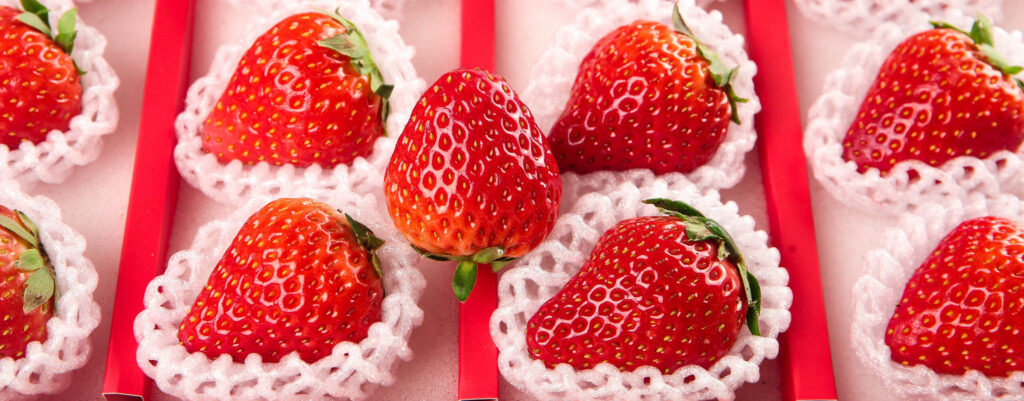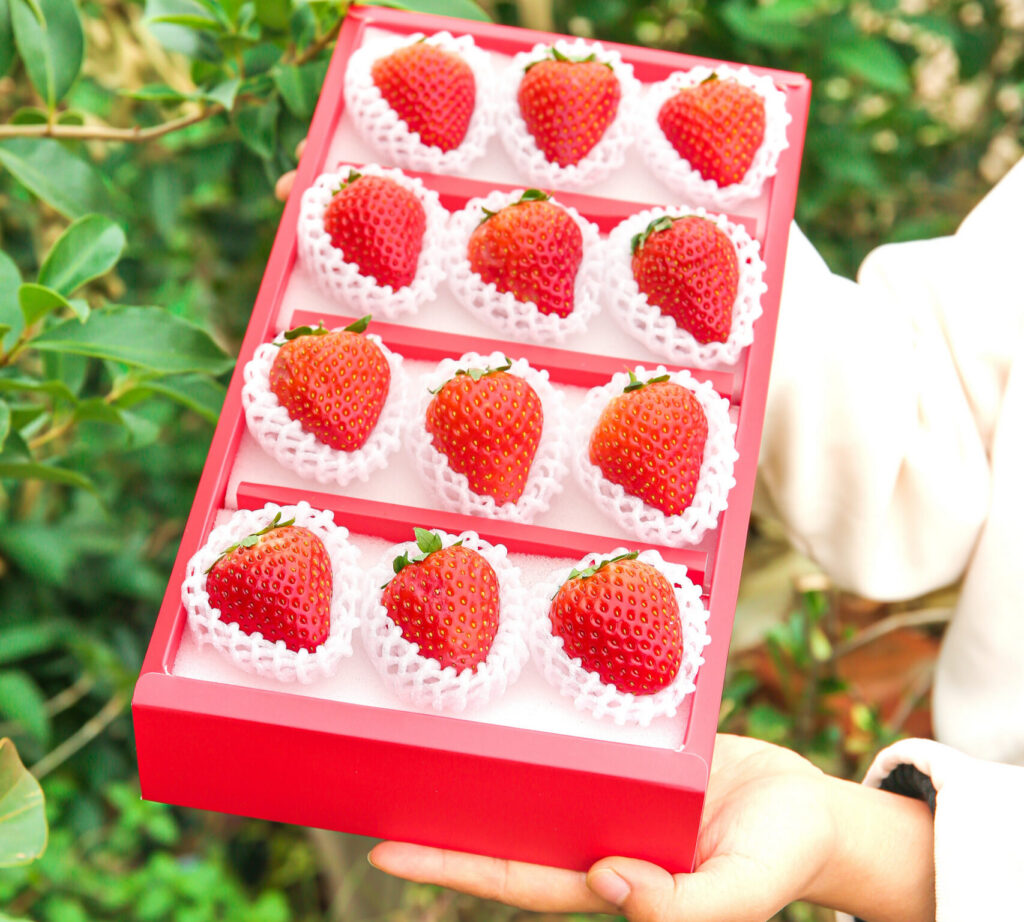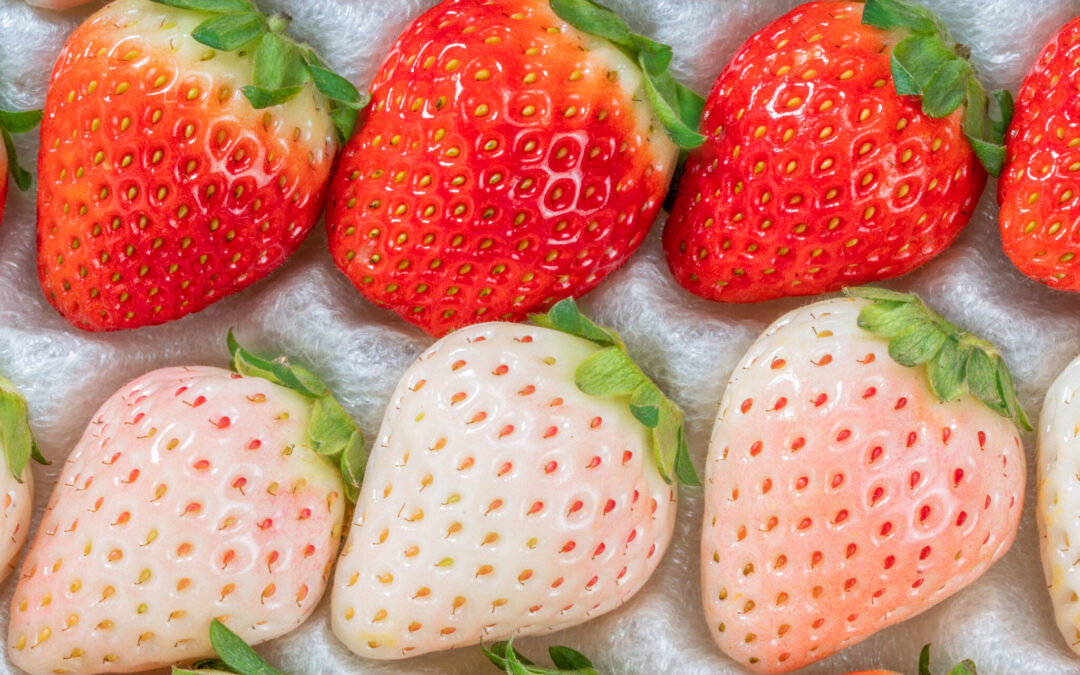A single strawberry shouldn’t cost more than your lunch. Yet Japanese strawberries are commanding premium prices – sometimes $50 or more per piece – and experiencing explosive 28% year-over-year growth with over 23 million social media posts. These aren’t your supermarket strawberries. They’re luxury fruits bred for perfection, prized for their appearance and sweetness, and increasingly showing up in everything from minimalist desserts to layered cakes across the Western world.
The Luxury Fruit Phenomenon
Japanese fruit cultivation represents an entirely different philosophy than Western industrial agriculture. In Japan, certain fruits are grown with meticulous attention to detail – each berry hand-pollinated, individually wrapped during growth to ensure perfect shape and color, and harvested only at peak ripeness. The result is fruit so perfect it barely resembles the produce section versions Americans know.
Japanese strawberries like the Omakase Berry, Bijin-hime, or Kotoka varieties are uniformly large, deeply red, symmetrical, and intensely sweet. They lack the tart bite of conventional strawberries. Their texture is tender rather than firm. Each berry represents dozens of hours of labor and expert cultivation knowledge passed down through generations.
In Japan, these luxury fruits serve as prestigious gifts. A perfect melon can sell for over $200. Premium grapes might cost $100 per cluster. The fruit isn’t just food – it’s an expression of respect, gratitude, or celebration. Giving someone immaculate fruit demonstrates you value them enough to purchase something requiring such care and expense.

The Western Obsession
What started as a niche curiosity among food enthusiasts has exploded into mainstream trend. Social media played a massive role – the visual perfection of Japanese strawberries makes them ideal Instagram content. When influencers started featuring $50 strawberries, curiosity spread rapidly.
The 23 million posts about Japanese strawberries aren’t just photos of fruit. They’re status symbols, luxury signals, and conversation starters. Posting yourself eating a $50 strawberry communicates something about your lifestyle and priorities. The experience becomes as important as the taste.
Restaurants and pastry chefs quickly recognized the appeal. Japanese strawberries started appearing in high-end desserts where their visual perfection and intense sweetness justified menu prices well above standard offerings. A single strawberry on a minimalist white plate can command $20 at upscale restaurants. Layered cakes featuring Japanese strawberries sell for premium prices.
Why People Pay
The pricing seems absurd until you understand what drives luxury food markets. These strawberries offer something mass-produced fruit cannot: uniqueness, story, and genuine quality difference. People who’ve tasted both regular and Japanese strawberries report the difference is unmistakable and significant.
Part of the appeal is experiential. In a world where most food is mass-produced and affordable, luxury versions of everyday items offer novelty and exclusivity. The same psychology that drives people to pay $20 for craft cocktails or $100 for omakase sushi applies to $50 strawberries. You’re not just buying fruit – you’re buying an experience and a story.
The health-conscious angle plays a role too. Japanese strawberries are grown with minimal chemicals, careful attention to soil health, and prioritization of flavor over yield or shelf life. For consumers concerned about pesticides and sustainable agriculture, the premium represents values-aligned purchasing.

The Broader Trend
Japanese strawberries are part of a larger luxury ingredient trend. Premium versions of ordinary foods – special honeys, artisanal butters, heritage grains, rare spices – are experiencing similar growth. As income inequality increases, luxury food markets expand to serve consumers willing and able to pay significantly more for perceived quality and exclusivity.
Social media amplifies this trend by creating FOMO around exclusive food experiences. When people see others enjoying $50 strawberries, curiosity drives trial. Some become regular customers, while others try once for the experience and content opportunity.
The sustainability of the trend remains debatable. Will $50 strawberries become normalized luxury the way $20 cocktails did? Or will the novelty fade as the market saturates? Early indicators suggest staying power – the 28% year-over-year growth shows no signs of slowing, and production is expanding to meet demand.
What It Means
The Japanese strawberry phenomenon reveals several things about contemporary food culture. Visual appeal matters enormously in the Instagram age. Quality differences that were once subtle or appreciated only by experts now drive mainstream purchasing decisions. Status signaling through food has reached new heights of specificity.
It also demonstrates that significant numbers of consumers will pay dramatic premiums for genuinely exceptional versions of ordinary foods. The race to the bottom on price isn’t the only market dynamic – there’s also a race to the top on quality for consumers seeking extraordinary.
Whether you find $50 strawberries ridiculous or fascinating says something about how you relate to food, luxury, and experiential consumption. But regardless of personal opinion, the numbers don’t lie: Japanese strawberries are a genuine trend with real staying power, supported by millions of posts, significant sales growth, and expanding availability.
The next time you’re scrolling Instagram and see someone eating an absurdly perfect strawberry, know that you’re witnessing the intersection of Japanese agricultural artistry, social media amplification, and Western luxury food markets. That $50 strawberry isn’t just fruit. It’s a cultural moment.


